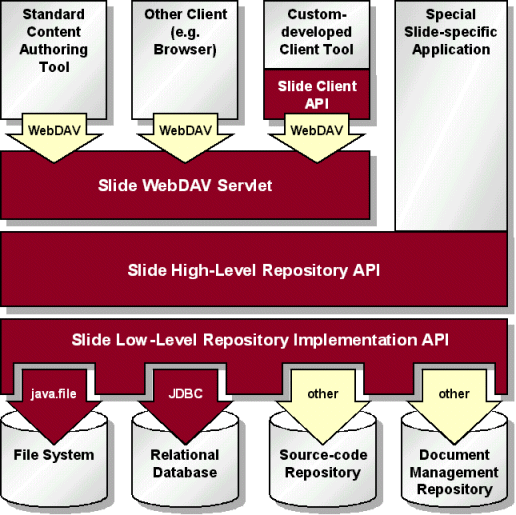
|

Architecture
The following diagram provides a high-level view of the Slide architecture.

The primary interface that Slide provides is a WebDAV interface; this interface allows connectivity with any WebDAV-enabled client tool, such as Microsoft Office 2000, DAV Explorer, Cadaver, or others. This interface is provided using a standard Java Servlet, which runs in Apache's Tomcat servlet engine, or any other engine that complies with the appropriate version of the servlet API.
Slide also provides an client WebDAV API, to make it easy to write client applications that talk to a Slide server, or any other WebDAV compliant server.
If you really want, however, you can write applications that talk directly to the high-level Slide Repository API. These applications would bypass the WebDAV protocol completely, but might be better optimized for performance.
Finally, this high-level interface abstracts a set of repository implementations; different people will want to implement slide against different repositories, and Slide provides a set of low-level repository interfaces that need to be implemented for each type of repository. Standard implementations for some repositories, such as the native file system and relational databases, have already been built, and are provided with Slide. Others implementations for other repositories will need to be developed.
Key Concept: The Namespace
One of the key concepts in Slide is the idea that resources contained in the Slide content management framework are organized into some namespace. Conceptually, this is similar to the web's URL namespace: various URLs define resources on the web which may reside on the completely different servers.
A Slide namespace is very similar.
The High-Level API
There are four key packages in the high-level API, plus two additional packages for common classes.

The four key packages include:
- structure
This package contains classes that help distinguish the different types of resources in the Slide namespace.
- authenticate
The authenticate package includes classes that are used for security.
- content
Theorg.apache.slide.contentpackage contains classes that are used for content management.
- lock
Theorg.apache.slide.lockpackage contains classes that are used to lock individual resources.
The WebDAV Servlet
There are three packages
Copyright © 2000 by B.C. Holmes. Last updated: June 28th, 2000
Slide Guide logo © by B.C. Holmes and Siobhan NiLoughlin.
Slide is a project by the Apache Software Foundation.